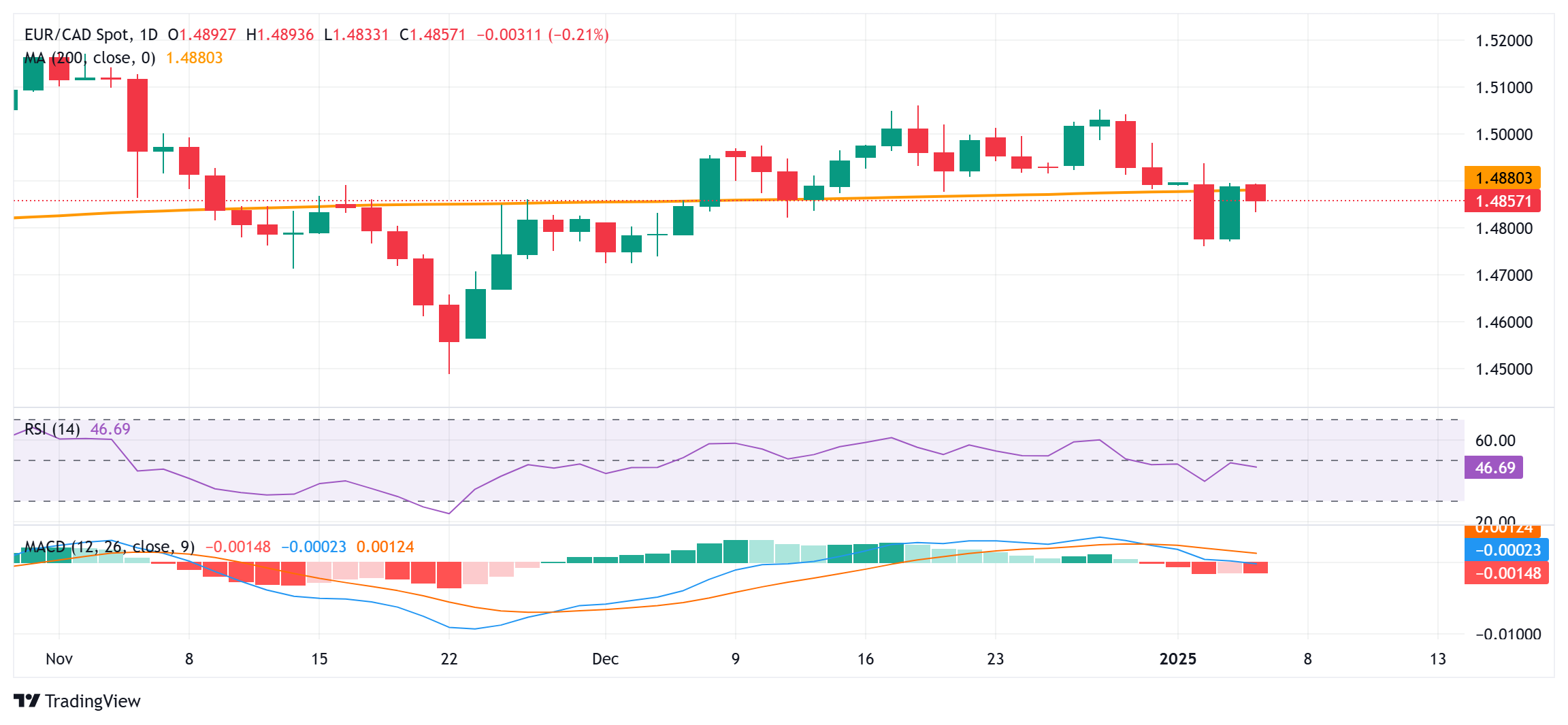EUR/CAD Price Forecast: Failure near 200-day SMA support-turned-resistance favors bearish traders
- EUR/CAD attracts fresh sellers on Monday and erodes a part of Friday’s modest recovery gains.
- The recent breakdown and failure near the 200-day SMA supports prospects for further losses.
- A sustained move and acceptance above the 1.4900 mark is needed to negative the negative bias.
The EUR/CAD cross struggles to capitalize on Friday's recovery move from the 1.4770 area, or the vicinity of a one-month low and meets with a fresh supply at the start of a new week. Spot prices remain depressed through the early European session and currently trade around the 1.4850-1.4845 region, down over 0.25% for the day.
The Canadian Dollar (CAD) strengthened across the board in reaction to reports that Canadian Prime Minister Justin Trudeau will step down as Liberal Party Leader and might announce his resignation as early as Monday. This, along with the recent rally in Crude Oil prices, underpins the commodity-linked Loonie and exerts some downward pressure on the EUR/CAD pair. The shared currency, on the other hand, draws some support from a softer US Dollar (USD), which, in turn, should help limit the downside for spot prices.
From a technical perspective, last week's breakdown below a short-term trading range support, which coincided with the very important 200-day Simple Moving Average (SMA), was seen as a key trigger for bearish traders. Moreover, oscillators on the daily chart have been gaining negative traction and suggest that the path of least resistance for the EUR/CAD cross is to the downside. Hence, a subsequent fall towards the 1.4800 mark, en route to the 1.4770 area or a one-month low, looks like a distinct possibility.
The next relevant support is pegged near the 1.4730 horizontal zone, below which the EUR/CAD pair could weaken further below the 1.4700 mark and accelerate the fall towards the 1.4645-1.4640 region. The downward trajectory could extend towards the 1.4600 round figure before spot prices eventually drop to the 1.4565-1.4560 area en route to the November 2024 swing low – levels just below the 1.4500 psychological mark.
On the flip side, the 200-day SMA, currently near the 1.4880 area, could act as an immediate hurdle ahead of the 1.4900 round figure and the 1.4935-1.4940 region. Some follow-through buying should assist the EUR/CAD cross to reclaim the 1.5000 psychological mark and retest the 1.5050-1.5060 supply zone.
EUR/CAD daily chart
Canadian Dollar FAQs
The key factors driving the Canadian Dollar (CAD) are the level of interest rates set by the Bank of Canada (BoC), the price of Oil, Canada’s largest export, the health of its economy, inflation and the Trade Balance, which is the difference between the value of Canada’s exports versus its imports. Other factors include market sentiment – whether investors are taking on more risky assets (risk-on) or seeking safe-havens (risk-off) – with risk-on being CAD-positive. As its largest trading partner, the health of the US economy is also a key factor influencing the Canadian Dollar.
The Bank of Canada (BoC) has a significant influence on the Canadian Dollar by setting the level of interest rates that banks can lend to one another. This influences the level of interest rates for everyone. The main goal of the BoC is to maintain inflation at 1-3% by adjusting interest rates up or down. Relatively higher interest rates tend to be positive for the CAD. The Bank of Canada can also use quantitative easing and tightening to influence credit conditions, with the former CAD-negative and the latter CAD-positive.
The price of Oil is a key factor impacting the value of the Canadian Dollar. Petroleum is Canada’s biggest export, so Oil price tends to have an immediate impact on the CAD value. Generally, if Oil price rises CAD also goes up, as aggregate demand for the currency increases. The opposite is the case if the price of Oil falls. Higher Oil prices also tend to result in a greater likelihood of a positive Trade Balance, which is also supportive of the CAD.
While inflation had always traditionally been thought of as a negative factor for a currency since it lowers the value of money, the opposite has actually been the case in modern times with the relaxation of cross-border capital controls. Higher inflation tends to lead central banks to put up interest rates which attracts more capital inflows from global investors seeking a lucrative place to keep their money. This increases demand for the local currency, which in Canada’s case is the Canadian Dollar.
Macroeconomic data releases gauge the health of the economy and can have an impact on the Canadian Dollar. Indicators such as GDP, Manufacturing and Services PMIs, employment, and consumer sentiment surveys can all influence the direction of the CAD. A strong economy is good for the Canadian Dollar. Not only does it attract more foreign investment but it may encourage the Bank of Canada to put up interest rates, leading to a stronger currency. If economic data is weak, however, the CAD is likely to fall.



